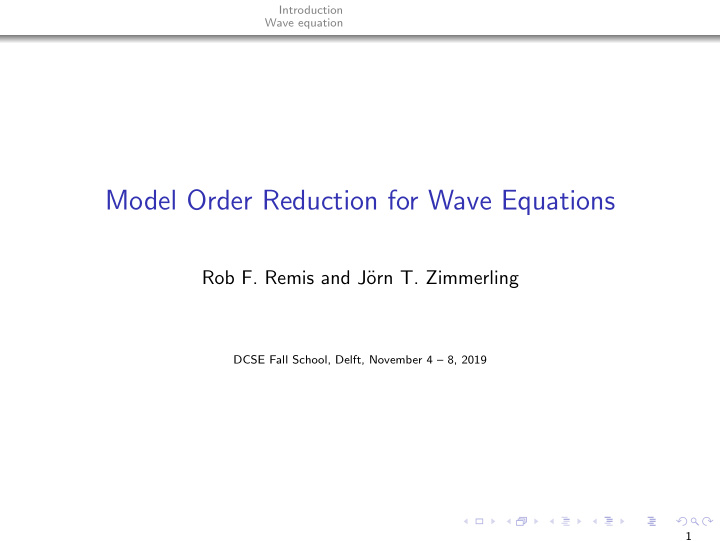



Introduction Wave equation Model Order Reduction for Wave Equations Rob F. Remis and J¨ orn T. Zimmerling DCSE Fall School, Delft, November 4 – 8, 2019 1
Introduction Wave equation Introduction Rob F. Remis Fac. of Electrical Engineering, Mathematics and Computer Science Delft University of Technology r.f.remis@tudelft.nl J¨ orn T. Zimmerling Department of Mathematics University of Michigan j.zimmerl@umich.edu 2
Introduction Wave equation Introduction Lecture 1: basic wave equations Lecture 2: Discretization and symmetry Lecture 3: Symmetry and Krylov model-order reduction Lecture 4: Capita selecta 3
Introduction Wave equation Introduction Reduced-order modeling (ROM) is a vast research area We focus on some ROM techniques for wave field problems Reduced-order model(ing) – ROM: Replace a large-scale system by a much smaller one Before you start, you should have good reasons to believe that a significant reduction can be achieved ROM for wave fields (hyperbolic problems) is hard, in general 4
Introduction Wave equation Introduction Possible ROM scenarios: Solve a forward problem efficiently Replace a large-scale model in a design/imaging/inversion process Replace a large-scale system, while preserving input-output characteristics and essential system properties (e.g. stability, passivity) of the unreduced system – structure preserving ROM Apply ROM to directly solve an imaging/inversion problem – data driven imaging 5
Introduction Wave equation Introduction - Example 1 Receiver Source PML 5500 5000 500 4500 1000 x-direction [m] 4000 Speed [m/s] × 10 -5 1500 1 3500 0.8 0.6 2000 3000 0.4 Response [a.u.] 0.2 2000 2500 3000 3500 4000 4500 5000 2500 2500 0 -0.2 -0.4 2000 3000 -0.6 -0.8 Comparison 1500 ROM 500 1000 1500 -1 0 1000 2000 3000 4000 5000 6000 7000 8000 9000 y-direction [m] Normalized Time 6
Introduction Wave equation Introduction - Example 2 Without pad With pad GRE TSE 22 b + 1 = b + 1;rom ( p ) , p = pad design parameter vector 7
Introduction Wave equation The Wave Equation The wave equation instantaneous reacting material ∇ 2 u − 1 c 2 ∂ tt u = − q u = u ( x , t ): wave field quantity of interest ∇ 2 : Laplacian ∂ tt : double derivative with respect to time q = q ( x , t ): source c ( x ): wave speed profile c (x) = c 0 for a homogeneous medium 8
Introduction Wave equation The Wave Equation Source has a bounded support in space Solve wave equation for given initial and boundary conditions The wave equation material exhibiting relaxation ∇ 2 u − 1 ∂ tt ( u + χ ∗ u ) = − q c 2 0 χ ( x , t ) is called the relaxation function of the material This function must be causal for t < 0 and x ∈ R 3 χ ( x , t ) = 0 9
Introduction Wave equation The Wave Equation Applying a one-sided Laplace transform gives Helmholtz’s equation ∇ 2 ˆ γ 2 ˆ u − ˆ u = − ˆ q with a propagation coefficient γ = ˆ ˆ γ 0 = s / c 0 instanteneous reacting and homogeneous γ = s / c ( x ) ˆ instanteneous reacting and inhomogeneous γ 2 = ˆ γ 2 ˆ 0 [1 + ˆ χ ( x , s )] with relaxation and inhomogeneous 10
Introduction Wave equation Maxwell’s equations Maxwell’s equations − ∇ × H + J c + ∂ t D = − J ext and ∇ × E + ∂ t B = 0 J ext [A/m 2 ]: external electric-current source (antenna) E : electric field strength [V/m] H : magnetic field strength [A/m] 11
Introduction Wave equation Maxwell’s equations J c [A/m 2 ]: electric conduction current D [C/m 2 ]: electric flux density B [T = Vs/m 2 ]: magnetic flux density How matter reacts to the presence of an EM field is described by the constitutive relations J c = J c ( E ) , D = D ( E ) , and B = B ( H ) 12
Introduction Wave equation Maxwell’s equations Maxwell’s equations in one dimension ∂ y H x + J c; z + ∂ t D z = − J ext z and ∂ y E z + ∂ t B x = 0 Vacuum Instantaneously reacting material Matter exhibiting relaxation 13
Introduction Wave equation Maxwell’s equations Vacuum J c; z = 0 , D z = ε 0 E z , and B z = µ 0 H z Parameters of vacuum permittivity of vacuum ε 0 permeability of vacuum µ 0 14
Introduction Wave equation Maxwell’s equations Instantaneously reacting material J c; z = σ ( x ) E z , D z = ε ( x ) E z , and B z = µ ( x ) H z Medium parameters conductivity σ permittivity ε permeability µ 15
Introduction Wave equation Maxwell’s equations Material exhibiting relaxation � t J c; z = 0 , D z = ε 0 E z + ε 0 χ e ( x , t − τ ) E z ( x , τ ) d τ, B z = µ 0 H z τ =0 χ e relaxation function of the material 16
Introduction Wave equation Maxwell’s equations Model that is often used (for gold at optical frequencies, for example) χ e ( t ) = ( ε ∞ − 1) δ ( t ) + ˜ χ e ( t ) with ∆ ε ω 2 �� � p ω 2 p − δ 2 χ e ( t ) = ˜ exp( − δ p t ) sin U ( t ) p � ω 2 p − δ 2 p U ( t ): Heaviside unit step function ω p : plasma frequency δ p : damping coefficient ∆ ε = ε s − ε ∞ 17
Recommend
More recommend